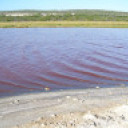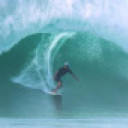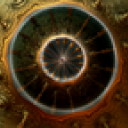Tides!?


G'day Nick! Yeah I've often pondered the miraculous way tide shifts, changes in swell size or direction, even wind can have so much effect in some places and not others. In fact I reckon I'd spend most of my time in the water trying to work it out at each break ( being from Melbourne that's tricky as there are so many breaks to visit on three coat lines!).
I did study coastal morphology briefly at uni so my guesses aren't entirely in educated. Basically I reckon it's too do with the waves interaction with the reef and ocean floor. As soon as a wave interacts with the either it will cause the wave to slow down at that point, also to grow in size and lose energy.
Some reefs are a very regular shape others are very irregular. Then there is the lead up too the reef, this could contain large rocks or small reefs which to varying degrees will fold the swell line in towards itself due to the swell line at this point allowing down. If a wave folds in on itself it will increase in size which can be seen in the iconic point break wave we all wet ourselves over.
So put this together, if you've got a very regular shape reef and a flat consistent lead up to the reef the tide has little effect on the wave. Then take it to the other extreme and you have an irregular reef with an irregular lead up then you basically end up with hundreds of ways the wave will interact with the reef and the lead up too the reef over various tides. Factor in swell size and direction and you start hearing the local who'll tell you the break on his door step is world class..... On its day...
Basically due to the various factors it's not worth trying to work it all out, just remember what made it work so you can be there again next time, doesn't stop me trying though!


While we're at it why are magic seaweed tides so much lower than a willyweather chart ?


First things first - tide times and heights are a forecast.
Local effects can influence the height of the tide, such as the inverse barometer effect, or coastal trapped waves. The times (and also the range) can be influenced by several factors, mainly being the location's distance from an amphidromic point (or node).
Swellnet's tides are sourced directly from the BOM however we map primary ports to each relevant surf location. So in Victoria, the Surf Coast and Mornington Peninsula are mapped to Port Phillip Heads. I think Phillip Island may be mapped to Western Port. We'd like to be able to delve into their secondary ports but I don't think this is currently available through the data feed we receive.
Other websites use a global forecast model that is different from the BOM. In fact, a while back I remember there being differences in the tide output in WA between the BOM and DPI's websites (point being: not everyone uses the same data, even if they are both governmental agencies!).


Could be the other factors I mentioned Nick - the inverse barometer effect, or a coastal trapped wave.
As a rough guide, the inverse barometer effect increases or decreases the sea height by 1cm for every 1hPa change in air pressure.
So, if we consider the average air pressure to be 1013hPa, then if the barometer is reading 993hPa, the sea level will be 20cm higher than usual. If the barometer is readng 1033hPa, then the water level will be 20cm lower than usual.
In order words, if you surfed location A on a 993hPa day, and then on a 1033hPa day, there would have been 40cm difference in sea level between both sessions.
As for a coastal trapped wave - it's a little harder to explain, but in short we often see the ocean 'pile up' across parts of the southern Australian coast under prolonged periods of westerly winds. This also increases the sea level.


thermalben wrote:Could be the other factors I mentioned Nick - the inverse barometer effect, or a coastal trapped wave.
As a rough guide, the inverse barometer effect increases or decreases the sea height by 1cm for every 1hPa change in air pressure.
So, if we consider the average air pressure to be 1013hPa, then if the barometer is reading 993hPa, the sea level will be 20cm higher than usual. If the barometer is readng 1033hPa, then the water level will be 20cm lower than usual.
In order words, if you surfed location A on a 993hPa day, and then on a 1033hPa day, there would have been 40cm difference in sea level between both sessions.
As for a coastal trapped wave - it's a little harder to explain, but in short we often see the ocean 'pile up' across parts of the southern Australian coast under prolonged periods of westerly winds. This also increases the sea level.
Interesting thread and this is even more interesting.


Oh and please when are we getting Indo tide times :P


Working on it ID.. they're a little harder to come by.


How accurate are tide watches ?


As accurate as the data they put into 'em. I have no idea what sources each brand uses.


You boys in SA gulf waters what does your tide watch read on a dodge tide ?


so do BOM, Willyweather or Swellnet account for forecast barometer pressures and or coastal trapped waves in their tide predictions?


No-one does. It's been on our to-do list for around eight years now.


Awesome, I'll add it to my ever increasing hypotheses about why a break was or wasn't working.
Any clues as to how to guess at the south westerly wind factor? I've heard it can add over a meter to the NE corner of Western Port.


Not sure. I've got an old paper from Gene Vecchio (former senior SA BOM forecaster, now retired) that he did around 15 years ago on coastal trapped waves but I can't remember if there's any formulas or look-up tables. It's in a box somewhere so I'll try to dig it out.


Nick b are your tides fading today / tmoro etc ? Was thinking bout you tday as I waded out over the last day of big tide for a paddle


Hah I know the spots your talking about nick bone. Would of been good tonight yeah? If the left held bigger than 2ft it would be the sickest slab.
Yeah caml tides are slowly starting to fade from tomorrow


Thought of another thing to think of Nick! The wave period. The distance between two wave peaks is equal to the depth at which the waves interact with the ocean floor. So wind swell can get to places a ground swell can't. Just another thing to think of between sets!


Not quite cb3d. The depth where the waves begin to feel the sea floor is half the wavelength.
cb3d wrote:So wind swell can get to places a ground swell can't.
Don't you mean the other way around?


I'll get out the text book when I get home, it's been a while! Now that I'm thinking about it ... nope I just fried my brain... I'll get back to you this evening!


Living in SA I remember having an older tide watch which just was set to one location and the bastard used to go all out of whack after every dodge so was pretty much useless - The modern watches which are area specific work much better here so use one of these now.... Now not sure if this is correct (could be an old wives tale) but from what I understand is it only SA and somewhere in South Africa which have dodge tides? And what causes a dodge?? and do you think rip curl will refund my watch purchase from 1998??!!


Dodge tides are unique to SA but yes I think a couple more locations around the world see near to no tidal movement through the monthly cycle.
It's caused by the tidal constituents all cancelling each other out.
IE the gravity from the sun/moon/earth along with the wave the tides flow though the gulfs, equalling each other out, resulting in little to no tidal movement.


West oz tides are not easy to work out either.


Low in November & high in may groundy


Righto. After a short period of data problems, our tide service has now been updated - and we have a more granular selection of locations available (all via the BOM). So, they should be a little more accurate in some locations than we previously had.
If anyone is having problems with the tides, please let me know!


I regularly surf a break requiring a minimum tide height, however somethimes it is definitely surf able on what should be a lower tide. Your air pressure variation makes completes sense as I had noticed a correlation between that and my guitar being out of tune . . . Long story suffice to say accoustic guitars are a bit like barometers.


I found this video quite interesting




After low tide (TIME), how many minutes after, does water start pushing into an estuary, directly on the foreshore?
Would like to know please, as I myself was perplexed from this phenomenon at Mooney , Nrth of Coffs a few months ago?????
Any answers from the tide gurus, would be much appreciated.
Cheers


wellymon wrote:After low tide (TIME), how many minutes after, does water start pushing into an estuary, directly on the foreshore?
Would like to know please, as I myself was perplexed from this phenomenon at Mooney , Nrth of Coffs a few months ago?????
Any answers from the tide gurus, would be much appreciated.
Cheers
Immediately after slack the rate increases at a speed dependent on the size of tide (distance between low and high). A basin such as Port Phillip bay will have water flowing out long after the low due to the funnel type effect.


Dont get me wrong, i can read a tide guide with ease. But the datum for the tides is somethjng i dont quite understand.
Where i live, its pretty straight forward, but we do have a couple of little reefs that work only on big high tides.
What i dont understand is how a 1.60 high tide can be sp different to a 1.50. Is that not only 10cm/100'mm in difference on the datum, which then confuses me as too how so little difference in water level can open up reefs that otherwise wouldnt be accessible?
I generally cross reference between these two sites.
http://tides.willyweather.com.au/vic/mornington-peninsula/sorrento-back-...
http://www.tide-forecast.com/locations/Port-Phillip-Heads-Australia/tide...
Willy weather states it uses data directly from the BoM, im not to sure about the other site.
I dont know if this is just a thing around here or if it happens Australia wide.
Also another thing is that BoM tide range is higher than the 'Tide Forecast' site. Apparently through word pf mouth, a couple of years ago the BoM changed the tide datum for Port Phillip Heads and reduced the tides by 10% (i.e a 1.6 would become a 1.44?)
Any info would be muchly appreciated. Cheers!!!